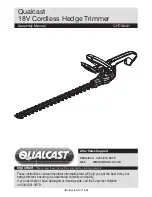
Radio dimmer RF-L UN-ST IP53 and RF-L LED-ST IP53
1
Radio dimmer RF-L UN-ST IP53 and RF-L LED-ST IP53
from software version 5.7 • Version: 16.05.2022 • Technical changes and errors excepted. • Elsner Elektronik GmbH • Sohlengrund 16 • 75395 Ostelsheim • Germany • www.elsner-elektronik.de •
Technical Service: +49 (0) 7033 / 30945-250
RF-L UN-ST IP53 and RF-L LED-ST IP53
Radio Dimmer
Technical specifications and installation instructions
Item numbers
60544 RF-L UN-ST IP53
60545 RF-L LED-ST IP53
1.
Description
RF-L UN-ST IP53 und RF-L LED-ST IP53
are radio dimmers for the WS1 and
WS1000 Color or Style, WS1000 Connect controls and for radio control system So-
lexa II. A halogen or fluorescent light is connected to the
RF-L UN-ST
. The
RF-L
LED-ST
is provided for LED lights. The radio dimmer allows dimming in 1% incre-
ments.
A light connected to the radio dimmer can also be operated directly using the remo-
te control Remo 8/pro via the button interface RF-B2-UP or the solar radio button
Corlo P RF (without an additional control unit).
Functions:
•
Universal dimmer with automatic load recognition (phase angle control/
phase sector control)
•
RF-L UN-ST
for hight-voltage/low-voltage halogen lamps in combination
with dimmable power supplies and for energy saving lamps,
load max. 300 W
•
RF-L LED-ST
for dimmable LED in combination with dimmable power
supplies, load 20 - 300 W
•
Reception of the radio control signal
•
Suitable for: WS1 Color, WS1 Style, WS1000 Color, WS1000 Style, KNX
WS1000 Style (from software version 1.8).
WS1000 Connect. Solexa II.
Remo 8 (from version 0.1), Remo pro, RF-B2-UP, Corlo P1 RF, Corlo P2 RF.
1.0.1. Deliverables
•
Radio dimmer
Available accessories:
•
Mains connection wire (5 m)
•
Connection wire (available in 1 m; 2,5 m; 5 m)
1.1. Technical data
*These
Radio dimmer RF-L UN-ST IP53 and RF-L LED-ST IP53
should be in-
stalled in a protected area despite a high degree of protection because water can en-
ter in via the connectors. Please observe the instructions in Chapter
Connection
.
The product conforms with the provisions of EU directives.
2.
Installation and start-up
Installation, testing, operational start-up and troubleshooting should
only be performed by an authorised electrician.
DANGER!
Risk to life from live voltage (mains voltage)!
There are unprotected live components inside the device.
• Inspect the device for damage before installation. Only put undamaged
devices into operation.
• Comply with the locally applicable directives, regulations and provisions for
electrical installation.
• Immediately take the device or system out of service and secure it against
unintentional switch-on if risk-free operation is no longer guaranteed.
Use the device exclusively for building automation and observe the operating inst-
ructions. Improper use, modifications to the device or failure to observe the opera-
ting instructions will invalidate any warranty or guarantee claims.
Operate the device only as a fixed-site installation, i.e. only in assembled condition
and after conclusion of all installation and operational start-up tasks, and only in the
surroundings designated for it.
Elsner Elektronik is not liable for any changes in norms and standards which may
occur after publication of these operating instructions.
2.1. Notes on wireless equipment
When planning facilities with devices that communicate via radio, adequate radio
reception must be guaranteed. The range of wireless control will be limited by legal
regulation and structural circumstances. Avoid sources of interference and obstac-
les between receiver and transmitter, that could disturb the wireless communicati-
on. Those would be for example:
•
Walls and ceilings (especially concrete and solar protection glazing).
•
Metal surfaces next to the wireless participants (e. g. aluminium construction
of a conservatory).
•
Other wireless devices and powerful local transmitters (e.g. wireless
headphones), which transmit on the same frequency. Please maintain a
minimum distance of 30 cm between wireless transmitters for that reason.
2.2. Connection
The radio module is connected between the appliance and the power supply. It may
only be connected to flexible lines using STAK/STAS connectors. The connectors
must be locked using the locking bow.
Do not expose to continuous sun radiation
to avoid overheating.
The housing is not UV-resistant.
•
Assembly the device in a protected area (e. g. in
the box for the blinds/marquee/shutters in a construction
profile beneath the roof tiles or in a housing).
No water may run along the supply line and device
because water
can enter in via the connectors
.
•
Assembly the device in a protected area (e. g. in
the box for the blinds/marquee/shutters in a construction
profile beneath the roof tiles or in a housing).
•
Lay the supply lines out and down from the device.
No vibrations!
•
Assemble the device in a place that is free of vibrations.
Housing
Plastic
Degree of protection
IP 53*
Dimensions (without
locking bow)
ca. 147 x 36 x 29 (W x H x D, mm)
Weight
approx. 140 g
Ambient temperature
Operation -20…+55°C, storage -30…+85°C
Ambient humidity
max. 95% RH, avoid condensation
Operating voltage
230V AC
Standby power consump-
tion
2 W
Input
STAS3 plug (230 V)
Output
STAK3 coupling,
loadable from 20 - 300 W (for RF-L LED-ST depending
on transformer also less than 20 W)
Radio frequency
868.2 MHz
The antenna symbol on the housing shows the position
of the antenna in
RF-L UN-ST IP53 und RF-L LED-ST
IP53
. This side must not be positioned directly on metal
surfaces or objects. Otherwise, the radio signal might
disturbed.
Metal
profile
RF
-L-S
T
EN




















